
The Guglers (also Güglers) were a body of mostly English and French knights who as mercenaries invaded Alsace and the Swiss plateau under the leadership of Enguerrand VII de Coucy during the Gugler War of 1375.

The Guglers (also Güglers) were a body of mostly English and French knights who as mercenaries invaded Alsace and the Swiss plateau under the leadership of Enguerrand VII de Coucy during the Gugler War of 1375.

The term Gugler is derived from the appearance of the knights dressed for winter, wearing hounskull (German : hundsgugel) helmets and cowl-like hoods, Gugle (or Gügle) being a Swiss German term for cowl or point. [1]
During lulls in the Hundred Years' War, unemployed knights and soldiers of free companies often rampaged and plundered the French countryside until they were again engaged and paid by French or English overlords to do their bidding. De Coucy gathered a mercenary army of such knights to enforce his inheritance rights versus his Habsburg relatives. [2] De Coucy's goal was to gain the Sundgau, Breisgau and the county of Ferrette. According to a treaty they had belonged to his Habsburg mother Catherine, daughter of Leopold I, Duke of Austria, but were retained by her relatives Albert III and Leopold III. [2]
The French king Charles V encouraged and financed de Coucy as he hoped to move these free companies off French lands. There is disagreement about the size of the army De Coucy put together, Tuchman estimates them to be a force of about 10,000 men, a contemporary Alsatian document names 16,000, and other writings place the numbers much higher. [1] As the army was plundering in groups it may not have presented a unified entity.
The mercenary forces assembled in the Alsace and plundered the Sundgau in October and November 1375. Forty villages were wrecked and people were killed or raped. Leopold was unable to defend the Alsace and retreated to Breisach on the Rhine. After Enguerrand's arrival in November some dissension arose about the next course of action. The Alsace had been plundered, winter was approaching, and the knights were unwilling to cross the Rhine. Coucy then led the army south.
In December 1375 the Gugler army crossed the Jura Mountains, entered the Aare valley and proceeded in three units. [2] Enguerrand de Coucy led the main army that headquartered at Saint Urban's Abbey, Jean de Vienne led the second unit and was stationed at Gottstatt Abbey, and Owain Lawgoch, the commander of the third unit, stayed at Fraubrunnen Abbey. [2] Some local nobles left their castles and fled to join Leopold, leaving the countryside open to the Guglers. Others resisted, among them Rudolph IV of Nidau, who was killed as the last of the Nidau counts. Resistance was also given by Petermann I von Grünenberg whose attempt to displace the Guglers from St. Urban was thwarted. [3] The pillage by the roaming Guglers affected the western part of the Aargau, where the towns of Fridau and Altreu were completely destroyed. [1]
The local populace organized to strike back and, although outnumbered, were able inflict significant damage in a series of night attacks, first defeating the Guglers at Buttisholz on Christmas Eve. [2] The canton of Bern subsequently formed a citizen army, killed several Guglers with apparently only minor losses at Ins on the night of 25-26 December, and led a decisive attack on Fraubrunnen Abbey on the night of 26-27 December. [2] Owain barely escaped, but another 800 knights were slain. These setbacks, the cold weather, and the obvious resolve of the Swiss populace, led to the retreat of the Guglers; their main army and Enguerrand were not even involved in any pitched battle along the line of retreat. [2]
In January 1376 the Guglers dissolved and returned to plunder the French countryside. Enguerrand compromised with Albert III in 1387 and received domain over Büren and part of the town of Nidau which he lost after only one year to the citizen army of Bern and Solothurn. [1] [2] The successful defense of their lands against foreign invaders helped the Swiss in strengthening their budding independence. They confirmed, after their previous successes at the battles of Morgarten (1315) and Laupen (1329), that well organized armies of common men could defeat knightly armour, a feat they would repeat a decade later at Sempach on their route to Swiss independence. The engagements of the Gugler War showed that the epoch of the medieval knight was coming to a close. [3] When questioned by the chronicler Froissart many years later, Enguerrand de Coucy flatly denied he had been in Switzerland at all. [1]

The canton of Bern, or Berne, is one of the 26 cantons forming the Swiss Confederation. Its capital city, Bern, is also the de facto capital of Switzerland. The bear is the heraldic symbol of the canton, displayed on a red-yellow background.

The Battle of Sempach was fought on 9 July 1386, between Leopold III, Duke of Austria and the Old Swiss Confederacy. The battle was a decisive Swiss victory in which Duke Leopold and numerous Austrian nobles died. The victory helped turn the loosely allied Swiss Confederation into a more unified nation and is seen as a turning point in the growth of Switzerland.
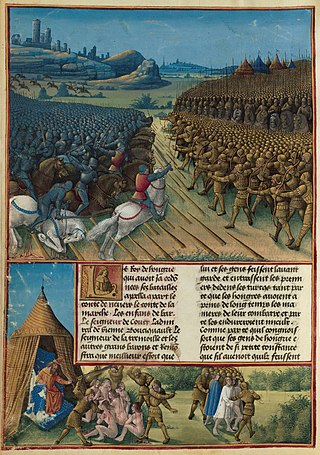
The Battle of Nicopolis took place on 25 September 1396 and resulted in the rout of an allied Crusader army at the hands of an Ottoman force, raising the siege of the Danubian fortress of Nicopolis and leading to the end of the Second Bulgarian Empire. It is often referred to as the Crusade of Nicopolis as it was one of the last big Crusades of the Middle Ages, together with the Crusade of Varna in 1443–1444. By their victory at Nicopolis, the Turks discouraged the formation of European coalitions against them. They maintained their pressure on Constantinople, tightened their control over the Balkans, and became a greater threat to Central Europe.

The Old Swiss Confederacy began as a late medieval alliance between the communities of the valleys in the Central Alps, at the time part of the Holy Roman Empire, to facilitate the management of common interests such as free trade and to ensure the peace along the important trade routes through the mountains. The Hohenstaufen emperors had granted these valleys reichsfrei status in the early 13th century. As reichsfrei regions, the cantons of Uri, Schwyz, and Unterwalden were under the direct authority of the emperor without any intermediate liege lords and thus were largely autonomous.

Leopold III, known as the Just, a member of the House of Habsburg, was Duke of Austria from 1365. As head and progenitor of the Leopoldian line, he ruled over the Inner Austrian duchies of Carinthia, Styria and Carniola as well as the County of Tyrol and Further Austria from 1379 until his death.

Enguerrand VII de Coucy,, also known as Ingelram de Coucy and Ingelram de Couci, was a medieval French nobleman and the last Lord of Coucy. He became a son-in-law of King Edward III of England following his marriage to the king's daughter, Isabella of England, and the couple was subsequently granted several English estates, among them the title Earl of Bedford. Coucy fought in the Battle of Nicopolis in 1396 as part of a failed crusade against the Ottoman Empire, but was taken prisoner and contracted the bubonic plague. He died in captivity the following year at Bursa.
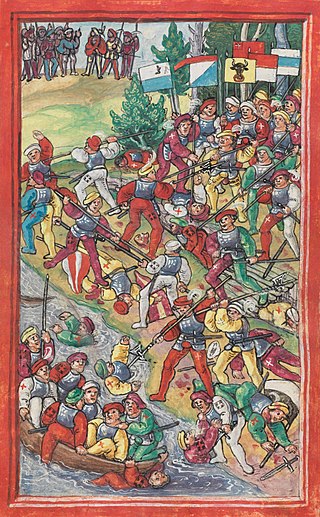
The Swabian War of 1499 (Alemannic German: Schwoobechrieg, called Schwabenkrieg or Schweizerkrieg in Germany and Engadiner Krieg was the last major armed conflict between the Old Swiss Confederacy and the House of Habsburg. What had begun as a local conflict over the control of the Val Müstair and the Umbrail Pass in the Grisons soon got out of hand when both parties called upon their allies for help; the Habsburgs demanding the support of the Swabian League, while the Federation of the Three Leagues of the Grisons turning to the Swiss Eidgenossenschaft. Hostilities quickly spread from the Grisons through the Rhine valley to Lake Constance and even to the Sundgau in southern Alsace, the westernmost part of the Habsburg region of Further Austria.
Sundgau is a geographical territory in the southern Alsace region, on the eastern edge of France. The name is derived from Alemannic German Sunt-gowe, denoting an Alemannic county in the Old High German period. The principal city and historical capital is Altkirch.

Owain Lawgoch, full name Owain ap Thomas ap Rhodri, was a Welsh soldier who served in Lombardy, France, Alsace, and Switzerland. He led a Free Company fighting for the French against the English in the Hundred Years' War. As a politically active descendant of Llywelyn the Great in the male line, he was a claimant to the title of Prince of Gwynedd and of Wales.

The Battle of Laupen was fought in June 1339, between Bern and its allies on one side, and Freiburg together with feudal landholders from the County of Burgundy and Habsburg territories on the other. Bern was victorious, consolidating its position in the region. As a consequence of the conflict, the relations of Bern and the Swiss Confederacy tightened, resulting in Bern's permanent accession in 1353.

Nidau is a municipality in the Biel/Bienne administrative district in the canton of Bern in Switzerland.
Wiedlisbach is a municipality in the Oberaargau administrative district in the canton of Bern in Switzerland.

Enguerrand VI was a medieval French nobleman who served as the Seigneur Lord of Coucy. He was also Lord Gynes, Sire d'Oisy, in the district of Marle, and the Sire de La Fère. He was the son of his predecessor, Guillaume, Lord of Coucy, Marle, Fère, Oisy, and Mount-Mirel, who held the titles from 1321–1335; and his second wife, Isabeau de Châtillon-St-Pol, daughter of Guy IV, Count of Saint-Pol.

Gottstat Monastery is a former Premonstratensian monastery in the municipality of Orpund in the Canton of Bern, Switzerland.

Nidau Castle is a castle in the municipality of Nidau of the Canton of Bern in Switzerland. It is a Swiss heritage site of national significance.
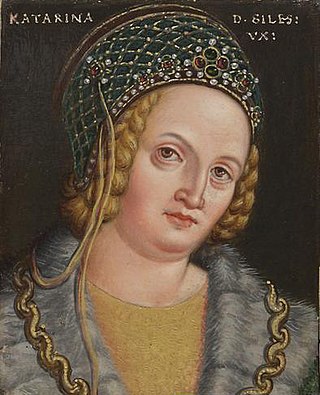
Catherine of Austria was the daughter of the Habsburg Duke Leopold I of Austria and the wife successively of the French nobleman Enguerrand VI, Lord of Coucy and the German Konrad von Hardeck, Burgrave of Magdeburg.

The ruins of Grünenberg Castle, Schnabelburg Castle and Langenstein Castle are a complex of three interconnected castles on a hill above the municipality of Melchnau in the canton of Bern in Switzerland. The three castles formed the center of power of the Barons of Grünenberg in the Oberaargau region during the High Middle Ages.
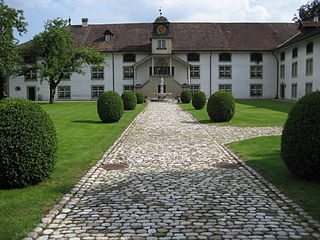
Fraubrunnen Abbey is a former Cistercian nunnery in the municipality of Fraubrunnen in the canton of Bern, Switzerland.
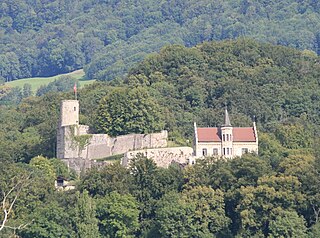
Bipp Castle is a partially ruined castle in the municipality of Oberbipp of the Canton of Bern in Switzerland.

Wiedlisbach Castle is a former tower house and defensive tower in the municipality of Wiedlisbach of the Canton of Bern in Switzerland.